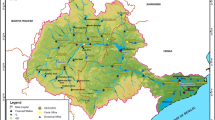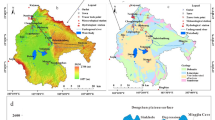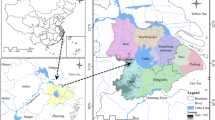Abstract
This study performs the multiscale decomposition of six water quality parameters from Elunuthimangalam station in Noyyal River, a water quality hotspot in Southern India, using the complete ensemble empirical mode decomposition with adaptive noise method. Then, the intrinsic mode functions (IMFs) obtained are subjected to normalized Hilbert transform-direct quadrature-coupled framework for their time–frequency characterization. The time–frequency–amplitude spectra revealed that the dominant frequency is dynamic in characteristics and the marginal spectra successfully captured the significant high anthropogenic interventions in the form of pollutant disposals in the study area. Then, an in-depth examination of the association of different water quality parameters such as pH, temperature, dissolved oxygen (DO), biochemical oxygen demand (BOD) and total hardness (TH) with electrical conductivity (EC) is done through a running correlation method, namely time-dependent intrinsic correlation (TDIC) in which the sliding window size is adaptively fixed based on instantaneous frequencies estimated by HT. The TDIC analysis revealed that with the exception of TH, the association of water quality parameters with EC in different time scales is not alike in both nature and strength. Also the well-debated DO–temperature and DO–BOD relationships displayed diverse correlation properties in different time scales and over the time domain.















Similar content being viewed by others
Abbreviations
- \(\overline{\overline{{C_{1} (t)}}}\) :
-
First mode obtained by CEEMDAN
- υo, υ1, υm :
-
Noise parameters for different steps
- Ci(t), Cj(t):
-
ith and jth IMFs
- Em(.):
-
Operator representing development of the mth mode by EMD
- M :
-
Number of IMFs
- n :
-
Index for the number of realizations
- N :
-
Number of realizations
- N t :
-
Length of the signal
- rm(t):
-
mth residual series
- wn(t):
-
nth realization of a white noise series
- X(t):
-
Time series signal
- Xn(t):
-
nth artificial signal obtained by addition of white noise
References
Adarsh S, Janga Reddy M (2014) Multiscale analysis of water quality time series data using the Hilbert Huang Transform. Int J Adv Comput Sci Appl 5(1):187–190
Adarsh S, Janga Reddy M (2016a) Multiscale characterization of streamflow and suspended sediment concentration data using Hilbert-Huang transform and time dependent intrinsic correlation analysis. Model Earth Syst Environ 2(4):1–17
Adarsh S, Janga Reddy M (2016b) Analysing the hydroclimatic teleconnections of summer monsoon rainfall in Kerala, India using multivariate empirical mode decomposition and time dependent intrinsic correlation. Geosci Remote Sens Lett 13(9):1221–1225
Adarsh S, Janga Reddy M (2018) Multiscale characterization and prediction of monsoon rainfall in India using Hilbert-Huang transform and time dependent intrinsic correlation analysis. Meteorol Atmos Phys 130(6):667–688
Adarsh S, Janga Reddy M (2019) Evaluation of trends and predictability of short-term droughts in three meteorological subdivisions of India using multivariate EMD-based hybrid modeling. Hydrol Process 33(1):130–143
Adarsh S, Sulaiman S, Murshida KK, Nooramol P (2017) Scale-dependent prediction of reference evapotranspiration based on multivariate empirical mode decomposition. Ain-Shams Eng J. https://doi.org/10.1016/j.asej.2016.10.104
Aghel B, Rezaei A, Mohadesi M (2018) Modeling and prediction of water quality parameters using a hybrid particle swarm optimization–neural fuzzy approach. Int J Environ Sci Technol. https://doi.org/10.1007/s13762-018-1896-3
Antico A, Schlotthauer G, Torres ME (2014) Analysis of hydro-climatic variability and trends using a novel empirical mode decomposition: application to Parana river basin. J Geophys Res Atmos 119(3):1218–1233
Babu A, Chinnaiyan P, Abhinaya S (2017) Effect of dyeing and textile industry on Noyyal river water quality, Tiruppur—a case study. Int J Civ Eng Technol 8(10):1064–1071
Bhandari NS, Nayal K (2008) Correlation study on physico-chemical parameters and quality assessment of Kosi river water, Uttarakhand. J Chem 5(2):342–346
Calif R, Schmitt FG, Huang Y (2016) Study of local correlations of the simultaneous wind speed-irradiance measurements using the time dependent intrinsic correlation method. J Appl Nonlinear Dyn 5(4):373–390
Chen X, Wu Z, Huang NE (2010) The time-dependent intrinsic correlation based on the empirical mode decomposition. Adv Adaptive Data Anal 2:233–265
CWC (2011) Water quality hotspots in India—a report by Central Water Commission
Derot J, Schmitt FG, Gentilhomme V, Morin P (2016) Correlation between long term marine temperature time series from eastern and western English channel: scaling analysis using empirical mode decomposition method. C R Geosci 348(5):343–349
Duan W, He B, Chen Y, Zou S, Wang Y, Nover D, Chen W, Yang G (2018) Identification of long-term trends and seasonality in high-frequency water quality data from the Yangtze River basin, China. PLoS ONE 13(2):e0188889. https://doi.org/10.1371/journal.pone.0188889
Franceschini S, Tsai CW (2010) Application of Hilbert-Huang Transform method for analyzing toxic concentrations in the Niagara river. J Hydrol Eng 15(2):90–96
Govindarajalu K (2003) Industrial effluent and health status—a case study of Noyyal river basin. In: Proceedings of the third international conference on environment and health, Chennai, India, 15–17 Dec 2003. Department of Geography, University of Madras and Faculty of Environmental Studies, Chennai
Grinsted A, Moore JC, Jevrejeva S (2004) Application of the cross wavelet transform and wavelet coherence to geophysical time series. Non-linear Process Geophys 11(5):561–566
Hu W, Si BC (2013) Soil water prediction based on its scale-specific control using multivariate empirical mode decomposition. Geoderma 193–194:180–188
Huang NE, Wu Z (2008) A review on Hilbert Huang Transform: method and its applications to geophysical studies. Rev Geophys. https://doi.org/10.1029/2007rg000228
Huang Y, Schmitt FG (2014) Time dependent intrinsic correlation analysis of temperature and dissolved oxygen time series using empirical mode decomposition. J Mar Syst 130:90–100
Huang NE, Shen Z, Long SR, Wu MC, Shih HH, Zheng Q, Yen NC, Tung CC, Liu HH (1998) The empirical mode decomposition and the Hilbert spectrum for nonlinear and non-stationary time series analysis. Proc R Soc A 454:903–995
Huang Y, Schmitt FG, Lu Z, Liu Y (2009a) Analysis of daily river flow fluctuations using empirical mode decomposition and arbitrary order Hilbert spectral analysis. J Hydrol 454:103–111
Huang NE, Wu Z, Long SR, Arnold KC, Blank K, Liu TW (2009b) On instantaneous frequency. Adv Adapt Data Anal 1(2):177–229
Ismail DKB, Lazure P, Puillat I (2015) Advanced spectral analysis and cross correlation based on empirical mode decomposition: application to the environmental time series. Geosci Remote Sens Lett 12(9):1968–1972
Jayanth Sarathi N, Karthik R, Logesh S, Srinivas Rao K, Vijayanand K (2011) Environmental issues and its impacts associated with the textile processing units in Tiruppur, Tamilnadu. In: Proceedings of 2nd international conference on environmental science and development, 26–28 Feb 2011 Singapore, IPCBEE 4, pp 120–124
Klionski DM, Oreshko NI, Geppener VV, Vasiljeva AV (2008) Applications of empirical mode decomposition for processing non-stationary signals. Pattern Recognit Image Anal 18(3):390–399
Koirala SR, Gentry RW, Perfect E, Mulholland PJ, Schwartz JS (2011) Hurst analysis of hydrologic and water quality time series. J Hydrol Eng 16(9):717–724
Kuai KZ, Tsai CW (2012) Identification of varying time scales in sediment transport using the Hilbert-Huang Transform method. J Hydrol 420–421:245–254
Kumar MR (2012) Dyeing and bleaching industrial pollution and its socio economic and environmental implications: a case experience from household in way side villages of Noyyal river Tamilnadu India. PhD thesis, Department of Economics, Bharatiyar university, Tamilnadu, India
Lee T, Ouarda TBMJ (2011) Prediction of climate non-stationary oscillation processes with empirical mode decomposition. J Geophys Res Atmos 116:D06107. https://doi.org/10.1029/2010JD015142
Lee J, Lee S, Yu S, Rhew D (2016) Relationships between water quality parameters in rivers and lakes: BOD5, COD, NBOPs, and TOC. Environ Monit Assess 188:252
Lehmann A, Rode M (2001) Long-term behaviour and cross-correlation water quality analysis of the river Elbe, Germany. Water Res 35(9):2153–2160
Liu S, Xu L, Li D (2016) Multi-scale prediction of water temperature using empirical mode decomposition with back-propagation neural networks. Comput Electr Eng 49:1–8
Magudeswaran PN (2004) Water quality assessment of Noyyal river. PhD thesis, Department of Chemistry, PSG College of Technology Coimbatore, Tamilnadu, India
Magudeswaran PN, Ramachandran T (2007) Water quality index of river Noyyal at Tirupur, Tamil Nadu, India. Nat Environ Pollut Technol 6(1):51–54
Manache G, Mecching CS (2008) Identification of reliable regression- and correlation-based sensitivity measures for importance ranking of water-quality model parameters. Water Res 23(5):549–562
Marimuthu KN, Thomas R, Yamini B, Bharathi S, Murugavel K (2015) Water pollution due to dying effluents in Noyyal river, Tirupur—a case study. Int J ChemTech Res 7(7):3075–3080
Massei N, Fournier M (2012) Assessing the expression of large scale climatic fluctuations in the hydrologic variability of daily Seine river flow (France) between 1950–2008 using Hilbert Huang Transform. J Hydrol 448–449:119–128
Mohan S, Vanalakshmi P (2013) Assessment of water quality in Noyyal river through water quality index. Int J Water Res Environ Eng 5(1):35–48
Naixia M, Hui W, Cuixia C, Wenbao L, Zijiang Y (2011) Hilbert Huang Transform based analysis of water quality parameters. In: Knowledge acquisition and modeling symposium, Sanya China, 8–9 Oct 2011, pp 365–369
Najafzadeh M, Ghaemi A, Emamgholizadeh S (2018) Prediction of water quality parameters using evolutionary computing-based formulations. Int J Environ Sci Technol. https://doi.org/10.1007/s13762-018-2049-4
Noori R, Sabahi MS, Karbassi AR, Baghvand A, TaatiZadeh H (2010) Multivariate statistical analysis of surface water quality based on correlations and variations in the data set. Desalination 260(1–3):129–136
Ouyang Y, NKedi-Kizza P, Wu Q-T, Schinde D, Huang CH (2006) Assessment of seasonal variations in surface water quality. Water Res 40(20):3800–3810
Parmar KS, Bhardwaj R (2013) Water quality index and fractal dimension analysis of water parameters. Int J Environ Sci Technol 10(1):151–164
Prabha S (2010) A study of the impact of textile effluent on water resources before and after the implementation of conventional and membrane bioreactor treatment systems: case study of Noyyal river at Tirupur industrial area, Southern India. PhD thesis, School of Environmental sciences, Jawaharlal Nehru University, New Delhi, India
Prathumratana L, Sthiannopkao S, Kim K-W (2008) The relationship of climatic and hydrological parameters to surface water quality in the lower Mekong River. Environ Int 34(2008):860–866
Rajkumar AS (2011) Studies on the decontamination of industrially polluted Orathupalayam dam sediments using bioremediation techniques. PhD thesis, Anna University
Rajkumar AS, Nagan S (2010a) Study of impact on Noyyal river and Orathupalayam dam due to effluent discharge by the textile dyeing industries in Tiruppur, Tamil Nadu and its remediation measures. Ind J Environ Prot 30(5):420–428
Rajkumar AS, Nagan S (2010b) Study on quality of effluent discharge by the Tiruppur textile dyeing units and its impact on river Noyyal, Tamil Nadu. J Environ Sci Eng 52(4):333–342
Rajkumar AS, Nagan S (2011) Study on Tiruppur CETPs discharge and their impact on Noyyal river and Orathupalayam dam, Tamil Nadu (India). J Environ Res Dev 5(3):558–565
Rao AR, Hsu EC (2008) Hilbert-Huang Transform analysis of hydrological and environmental time series. Springer, Cham
Rodo X, Rodriguez-Arias MA (2006) A new method to detect transitory signatures and local time/space variability structures in the climate system: the scale-dependent correlation analysis. Clim Dyn 27:441–458
Sang Y, Singh V, Sun F, Chen Y, Liu Y, Yang M (2016) Wavelet-based hydrological time series forecasting. J Hydrol Eng. https://doi.org/10.1061/(ASCE)HE.1943-5584.0001347
Srinivasan V, Suresh Kumar D, Chinnasamya P, Sulagnaa S, Sakthivel D, Paramasivamb P, Lelea S (2014) Water management in the Noyyal river basin: a situation analysis. Environment and development discussion paper no. 2. Ashoka Trust for Research in Ecology and the Environment, Bengaluru
Torres ME, Colominas MA, Schlotthauer G, Fladrin P (2011) A complete ensemble empirical mode decomposition with adaptive noise. In: IEEE international conference on acoustic speech and signal processing, Prague, 22–27 May 2011, pp 4144–4147
Wang F, Wang X, Zhao Y, Yang ZF (2014) Long-term periodic structure and seasonal-trend decomposition of water level in Lake Baiyangdian, Northern China. Int J Environ Sci Technol 11(2):327–338
Wu Z, Huang NE (2004) Statistical significance test of intrinsic mode functions. In: Huang NE, Shen SSP (eds) Hilbert-Huang Transform and its applications. World Scientific Publishing, Singapore
Wu Z, Huang NE (2005) Ensemble empirical mode decomposition: a noise-assisted data analysis method. Centre for Ocean–Land–Atmospheric studies technical report. 193, Centre for Ocean–Land–Atmos. Stud., Calverton, Md. 1-51. ftp://grads.iges.org/pub/ctr/ctr_193.pdf. Accessed 15 Aug 2017
Wu L, Cao CC, Hsu T, Jao K, Wang Y (2011) Ensemble empirical mode decomposition on storm surge separation from sea level data. Coast Eng J 53(3):223–243
Xiang Y, Wang X, He L (2016) Spatial-temporal analysis of environmental data of north Beijing district using Hilbert-Huang transform. PLoS ONE 11(12):e0167662
Yaseen DA, Scholz M (2018) Textile dye wastewater characteristics and constituents of synthetic effluents: a critical review. Int J Environ Sci Technol. https://doi.org/10.1007/s13762-018-2130-z
Zhang H, Gai Q (2006) Research on properties of empirical mode decomposition method. In: Proceedings of 6th World Congress on intelligent control and automation. IEEE, Dalian
Acknowledgements
The leading author expresses his gratitude to Dr. Francois G. Schmitt, Director, Laboratory of Oceanology and Geosciences (LOG), University of Lille, Wimereux, France, for the technical discussions on HHT and TDIC methods held at LOG in 2014. The authors thank Yongxiang Huang (https://zenodo.org/record/9748#.XBhUF2lS-Uk) and Patrick Flandrin (http://perso.ens-lyon.fr/patrick.flandrin/emd.html) for providing the basic source codes of TDIC and CEEMDAN methods with the intention of promoting non-commercial scientific research.
Author information
Authors and Affiliations
Corresponding author
Additional information
Editorial responsibility: Ta Yeong Wu.
Rights and permissions
About this article
Cite this article
Adarsh, S., Priya, K.L. Multiscale running correlation analysis of water quality datasets of Noyyal River, India, using the Hilbert–Huang Transform. Int. J. Environ. Sci. Technol. 17, 1251–1270 (2020). https://doi.org/10.1007/s13762-019-02396-2
Received:
Revised:
Accepted:
Published:
Issue Date:
DOI: https://doi.org/10.1007/s13762-019-02396-2




